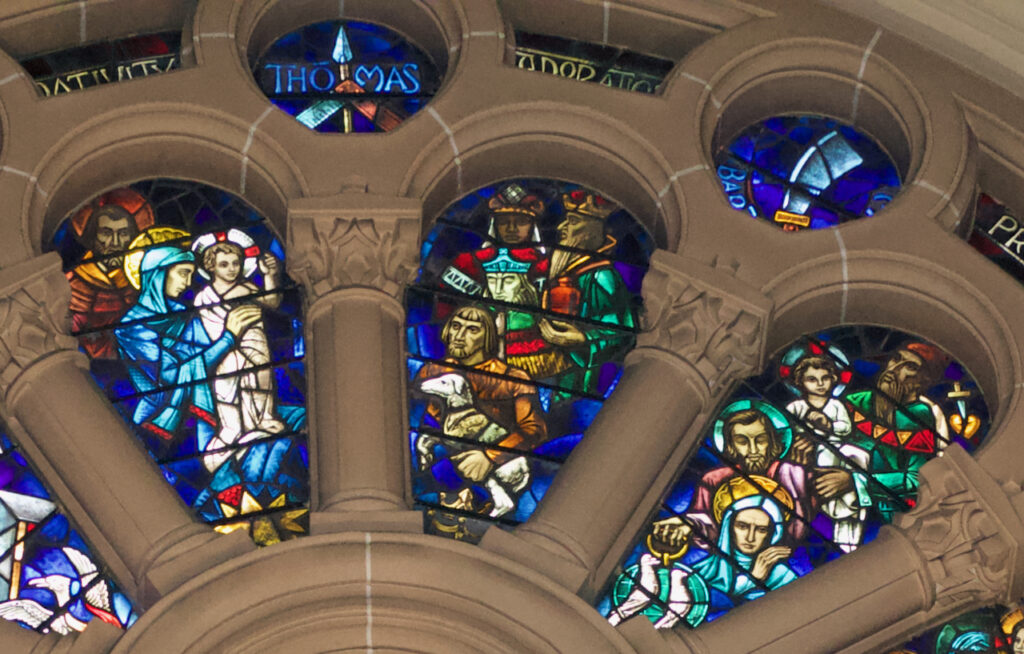Christmas and the Infancy Narratives
in the Windows of St. Joseph’s Monastery Church

The Rosette Window over the choir loft is dedicated to Jesus, the Son of God. The top two panes depict the Christmas story from both Matthew’s and Luke’s gospels. Mary, Joseph and Jesus are in the pane on the left and the Magi and a shepherd are in the pane on the right. The shepherd is holding his sheep. It was to the shepherds, the lowly people of society, that the angels made the announcement of the birth of the Savior. The shepherds went “in haste” to find the baby and spread the news of Jesus’ birth to all they met.
The Magi were “astrologers from the east.” They had observed the rising of a star and followed it to find the newborn King of the Jews. Beneath the feet of Jesus is the star that led the Magi to him and beneath the shepherd is a crown, symbol of the newborn king. The Magi were not Jews and foreshadow the fact that the salvation Jesus brings is for all people in all times. They brought gifts of gold, frankincense, and myrrh symbolizing Jesus’ kingship, deity, and death. The Feast of Epiphany celebrates the coming of the Magi.
The next pane depicts the Presentation of Jesus in the Temple, which occurred forty days after his birth and was a ritual of purification and dedication of the child to God in the Jewish tradition. Mary and Joseph brought with them the sacrifice of the poor, two doves, which can be seen at the bottom of the pane. In the temple, they met Simeon, who is holding Jesus and who prophesied about what this child would become. He also prophesied that Mary’s heart would be pierced as with a sword. A heart with the sword can be seen over Simeon’s shoulder. It is very similar to the Passionist symbol which is the heart of Jesus with the cross rising from it. The position of Mary’s hand in this pane is the same as in the Christmas pane in which she is holding Jesus; but with Jesus not there, it seems to be warding off the image of her pierced heart. This parallel image of hands is also present in other places in this rosette window. The Feast of the Presentation is on February 2, but the story is often associated with Christmas.
As we ponder the mystery of the uniting of God’s divinity with our humanity in Jesus, let’s ask ourselves how we will respond to the news that the Savior is born anew in our hearts and lives among us today.
I love these windows even more now! Thank you for the thorough explanations of all the images and imagery. Beautiful!!!
I don’t have a camera capable of taking pictures like these of the beautiful Rosette window. Now I can really appreciate the restoration work, and your wonderful insight into the symbolism gives me a deeper understanding of how complex these images really are. Thanks, Ann!
It is amazing how much was packed into these windows and how easy it is to miss the symbolism. Think of the many people who were illiterate but were able to learn from the stained glass depictions!
Hi Ann, So enjoyed this reflection of the Rosette and it’s meaning and symbolism. I love looking at the stained glass in our church and learning their interpretations. Thank you for this!
Thank you. Ann
These windows are so rich in symbolism! Thank you for writing these posts and suggesting ways to deepen our own reflection.
Thank you for visiting my site and helping me check out how these comments work.
I agree Barbara. No matter how many times I hear the Christmas story there is something that always hits me more deeply and this reflection made that happen again.
I often notice new things in the windows, too, when I go back and pray with them again.